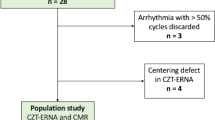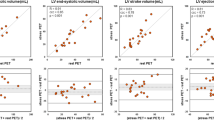Abstract
Background
Recent advances in the treatment of primary pulmonary hypertension (PPH), and in surgery to correct tetralogy of Fallot (TOF), have rekindled interest in evaluating right ventricular (RV) volume and ejection fraction (EF). The purpose of this investigation was to determine the accuracy of RV functional parameters assessed by single photon emission computed tomography (SPECT) equilibrium radionuclide angiography (ERNA).
Methods and Results
Twenty-eight patients with PPH (n = 15) or TOF (n = 13) (aged 28 ± 14 years; 57% male) were analyzed by means of SPECT ERNA algorithms that automatically identified mid-RV tomographic planes, generated regions isolating the right ventricle from other structures, and presented RV-segmented regions as a cinematic display. RV EF and volumes were computed and compared with values obtained by magnetic resonance imaging (MRI). Mean values were not different between SPECT ERNA and MRI for RV EF, end-diastolic volume, and end-systolic volume (42% ± 11% vs 41% ± 10%, 135 ± 67 mL vs 139 ± 91 mL, and 87 ± 54 mL vs 85 ± 61 mL, respectively; P = not significant for all comparisons). Significant linear correlation (P < .0001) was found between SPECT ERNA and MRI for RV EF, end-diastolic volume, and end-systolic volume (r = 0.85, r = 0.94, and r = 0.93, respectively). No statistically significant trends or biases for RV EF were found. Intraobserver and interobserver comparisons demonstrated good reproducibility. As expected, RV volume was significantly higher and RV EF was significantly lower for patients with PPH and TOF than were values for individuals at low likelihood for coronary artery disease or other cardiac disease.
Conclusions
SPECT ERNA provides accurate, reproducible assessment of RV volumes and EF and should prove useful in evaluating the magnitude of RV dysfunction in patients and in providing an objective means with which to assess the results of therapeutic interventions. (J Nucl Cardiol 2002;9:153–60.)
Similar content being viewed by others
References
Barst RJ, Rubin LJ, Long WA, McGoon MD, Rich S, Badesch DB, et al. A comparison of continuous intravenous epoprostenol (prostacyclin) with conventional therapy in primary pulmonary hypertension. New Engl J Med 1996; 334: 296–301.
Schamberger MS, Hurwitz RA. Course of right and left ventricular function in patients with pulmonary insufficiency after repair of tetralogy of Fallot. Pediatr Cardiol 2000; 21: 244–8.
Berger HJ, Matthay RA, Loke J, Marshall RC, Gottschalk A, Zaret BL. Assessment of cardiac performance with quantitative radionuclide angiocardiography: right ventricular ejection fraction with reference to findings in chronic obstructive pulmonary disease. Am J Cardiol 1978; 41: 897–905.
Maltz DL, Treves S. Quantitative radionuclide angiocardiography. determination of Qp:Qs in children. Circulation 1973; 47: 1049–56.
Maddahi J, Berman DS, Matsuoka DT, Waxman AD, Stankus KE, Forrester JS, et al. A new technique for assessing right ventricular ejection fraction using rapid multiple-gated equilibrium cardiac blood pool scintigraphy: description, validation and findings in chronic coronary artery disease. Circulation 1979; 60: 581–9.
Schulman DS. Assessment of the right ventricle with radionuclide techniques. J Nucl Cardiol 1996; 3: 253–64.
Markewicz W, Sechtem U, Higgins CB. Evaluation of the right ventricle by magnetic resonance imaging. Am Heart J 1987; 113: 8–15.
Bouchard A, Higgins CB, Byrd BF III, Amparo EG, Osaki L, Axelrod R. Magnetic resonance imaging in pulmonary arterial hypertension. Am J Cardiol 1985; 56: 938–42.
Johnson DE, Vacek J, Gollub SB, Wilson DB, Dunn M. Comparison of gated cardiac magnetic resonance imaging and two-dimensional echocardiography for the evaluation of right ventricular thrombi: a case report with autopsy correlation. Cathet Cardiovasc Diagn 1988; 14: 266–8.
Sechtem U, Pflugfelder PW, Gould RG, Cassidy MM, Higgins CB. Measurement of right and left ventricular volumes in healthy individuals with cine MR imaging. Radiology 1987; 163: 697–702.
Boxt LM, Katz J, Kolb T, Czegledy FP, Barst RJ. Direct quantitation of right and left ventricular volumes with nuclear magnetic resonance imaging in patients with primary pulmonaryun hypertension. J Am Coll Cardiol 1992; 19:1508–15.
Faber TL, Stokely EM, Templeton GH, Akers MS, Parkey RW, Corbett JR. Quantification of three-dimensional left ventricular segmental wall motion and volumes from gated tomographic radionuclide ventriculograms. J Nucl Med 1989;30:638–49.
Bartlett ML, Srinivasan G, Barker WC, Kitsiou AN, Dilsizian V, Bacharach SL. Left ventricular ejection fraction. comparison of results from planar and SPECT gated blood-pool studies. J Nucl Med 1996;37:1795–9.
Groch MW, Marshall RC, Erwin WD, Schippers DJ, Barnett CA, Leidholt EM Jr. Quantitative gated blood pool SPECT for the assessment of coronary artery disease at rest. J Nucl Cardiol 1998;5:567–73.
Van Kriekinge SD, Berman DS, Germano G. Automatic quantification of left ventricular ejection fraction from gated blood pool SPECT. J Nucl Cardiol 1999;6:498–506.
Chin BB, Bloomgarden DC, Xia W, Kim HJ, Fayadz ZA, Ferrari VA, et al. Right and left ventricular volume and ejection fraction by tomographic gated blood-pool scintigraphy. J Nucl Med 1997;38:942–8.
Vanhove C, Franken PR, Defrise M, Momen A, Everaert H, Bossuyt A. Automatic determination of left ventricular ejection fraction from gated blood-pool tomography. J Nucl Med 2001;42:401–7.
Christian PE, Nortmaan CA, Taylor A. Comparison of fully automated and manual ejection fraction calculations: validation and pitfalls. J Nucl Med 1985;26:775–82.
Nichols K, Yao SS, Kamran M, Faber TL, Cooke CD, DePuey EG. Clinical impact of arrhythmias on gated SPECT cardiac myocardial perfusion and function assessment. J Nucl Cardiol 2001;8:19–30.
Crawford CR. CT filtration aliasing artifacts. IEEE Trans Med Imaging 1991;10:99–102.
Nichols K, DePuey EG, Rozanski A. Automation of gated tomographic left ventricular ejection fraction. J Nucl Cardiol 1996;3:475–82.
Joint National Committee on Detection, Evaluation, and Treatment of High Blood Pressure. The fifth report of the Joint National Committee on Detection, Evaluation, and Treatment of High Blood Pressure (JNC V). Arch Intern Med 1993;153:154–83.
Chronic cor pulmonale. Report of an expert committee. World Health Organ Tech Rep Ser 1961;213:1–51.
Geddes D, Davies M, Koyama H, Hansell D, Pastorino U, Pepper J, et al. Effect of lung-volume-reduction surgery in patients with severe emphysema. New Engl J Med 2000;343:239–45.
Links JM, Becker LC, Rigo P, Taillefer R, Hanelin L, Anstett F, et al. Combined corrections for attenuation, depth-dependent blur, and motion in cardiac SPECT: a multicenter trial. J Nucl Cardiol 2000;7:414–25.
Faber TL, Cooke DC, Folks RD, Vansant JP, Nichols KJ, DePuey EG, et al. Left ventricular function from gated SPECT perfusion images: an integrated method. J Nucl Med 1999;40:650–9.
Iskandrian AS, Hakki AH, Goel IP, Mundth ED, Kane-Marsch SA, Schenk CL. The use of rest and exercise radionuclide ventriculography in risk stratification in patients with suspected coronary artery disease. Am Heart J 1985;110:864–72.
Fuster V, Gersh BJ, Giuliani ER, Tajik AJ, Brandenburg RO, Frye RL. The natural history of idiopathic dilated cardiomyopathy. Am J Cardiol 1981;47:525–31.
Germano G, Kiat H, Kavanaugh PB, Mariel M, Mazzanti M, Su HT, et al. Automatic quantification of ejection fraction from gated myocardial perfusion SPECT. J Nucl Med 1995;36:2138–47.
Rozanski A, Nichols K, Yao SS, Malhotra S, Cohen R, DePuey EG. Development and application of normal limits for left ventricular ejection fraction and volume measurements from Tc-99m sestamibi myocardial perfusion gated SPECT. J Nucl Med 2000;41:1445–50.
Author information
Authors and Affiliations
Corresponding author
Rights and permissions
About this article
Cite this article
Nichols, K., Saouaf, R., Ababneh, A.A. et al. Validation of SPECT equilibrium radionuclide angiographic right ventricular parameters by cardiac magnetic resonance imaging. J Nucl Cardiol 9, 153–160 (2002). https://doi.org/10.1067/mnc.2002.119464
Received:
Accepted:
Issue Date:
DOI: https://doi.org/10.1067/mnc.2002.119464




